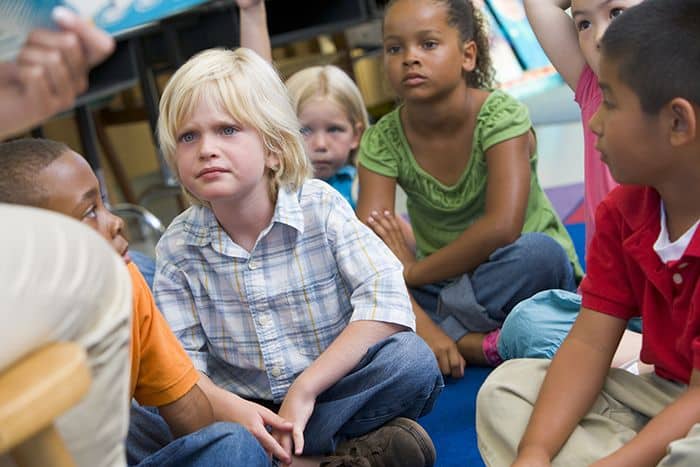Back To School – Hearing Loss and Its Implications for Learning and Communication

Back To School – Hearing Loss and Its Implications for Learning and Communication
Poor hearing is a serious problem for children. It affects their ability to learn to speak, read and be educated.
If you want to learn more about hearing loss, check out our resources:
Hearing Loss and Children: The Facts and Why They Are Important!
What Are the Types of Hearing Loss?
- Conductive – hearing loss resulting from disorders of the outer and/or middle ear (e.g., resulting from ear infections, abnormal ear structures)
- Sensorineural – hearing loss resulting from disorders of the inner ear or the 8th cranial nerve that carries the auditory signals to the brain (e.g., resulting from meningitis, noise exposure, problems at birth)
- Mixed – a combination of conductive and sensorineural hearing loss
- Central – results from disorders of the central auditory nervous system (e.g., central auditory processing disorders)
How Does Hearing Loss Affect Children?
Conductive Hearing Loss
Audiological Implications
– Hearing loss may be bilateral (both ears) or unilateral (one ear)
– Hearing loss may be fluctuating, permanent, or temporary
– Children may have difficulty
• With auditory reception and consistently organizing auditory information
• Understanding speech
• Understanding in adverse listening conditions
• Localizing sounds and understanding speech in the presence of competing noise (unilateral hearing loss)
• Loss of binaural listening advantage (unilateral hearing loss)
– Medical consultation and/or monitoring may be indicated
– The use of personal and/or group amplification and/or hearing assistive technology should be considered if hearing loss cannot be resolved through medical treatment
Communication Implications
– Children may have
• Difficulty forming linguistic categories (plurals, tenses)
• Difficulty differentiating words and sounds
• Receptive and/or expressive language delay
• Problems with articulation
Academic Implications
– Children may have
• Lower scores on achievement and verbal IQ tests
• Poor reading and spelling performance
• Greater need for enrolment in special education or support classes
• Lower performance on measures of social maturity
Sensorineural Hearing Loss
Audiological Implications
– Hearing loss may be bilateral or unilateral
– Children can exhibit
• Difficulty understanding speech and with auditory discrimination
• Significant problems listening and understanding in noisy and reverberant environments
• Difficulty localizing sounds and understanding speech in the presence of competing noise (unilateral hearing loss)
• Loss of binaural listening advantage (unilateral hearing loss)
– Use of personal and/or group amplification and/or hearing assistive technology should be considered
Communication Implications
– Children typically exhibit delays and/or difficulty with
• Tasks involving language concepts
• Auditory attention and memory, and comprehension
• Receptive and expressive language
• Syntax, semantics, and vocabulary development
• Speech perception and production
Academic Implications
– Children typically exhibit
• Lags and deficits in academic achievement, including language arts, vocabulary development, reading, spelling, arithmetic, and problem-solving
• Verbally based learning difficulties
• Progressive educational delays
– In addition, children with sensorineural hearing loss may have
• High rates of grade repetition and academic failure
• Self-described feelings of isolation, exclusion, embarrassment, annoyance, confusion, and helplessness
• Less independence in the classroom
• Lags in psychosocial development
– Increased need for special education and/or classroom supports
Mixed Hearing Loss Implications
– Hearing loss may be bilateral or unilateral, with various components of both sensorineural and conductive hearing losses.
– As with conductive and sensorineural hearing losses, a variety of audiological interventions and referrals may be indicated.
– Children can exhibit some or all of the audiological, communication, and academic implications of sensorineural and conductive hearing losses.
Central Auditory Processing Disorder Implications
– Hearing sensitivity is typically normal but a hearing loss could be present.
– Children may
• Behave as if they have hearing loss
• Score lower on measures of verbal IQ than on measures of performance
• Require more help with organization in the classroom
• Have difficulty following multiple step directions
• Refuse to participate in class discussions or respond inappropriately
• Act withdrawn or sullen
• Have a history of chronic ear infections or other otologic and/or neurologic problems
• Have poor singing and music skills
• Have deficiencies in fine and/or gross motor skills
Is Your Child at Risk for Hearing Loss?
Behaviours of Children at Risk for Hearing Loss
– Do not startle to loud sounds during infancy
– Do not turn in the direction of sounds after 7 months of age
– Have a history of 3 or more ear infections in one year
– Often misunderstand what is said
– Constantly request that information be repeated
– Frequently say “huh” or “what”
– Have difficulty following verbal instructions
– Give inconsistent responses to auditory stimuli
– Turn up the volume of the television, radio or stereo
– Give slow or delayed response to spoken directions or requests
– Have poor auditory attention
– Have poor auditory memory (span and sequence)
– Are easily distracted
– Have difficulty listening or paying attention in the presence of background noise
– Have delayed receptive and expressive language
– Have difficulty with phonics and speech sound discrimination
– Learn slowly through the auditory channel
– Have reading, spelling and other academic problems
– Exhibit behaviour problems
Children with hearing loss may exhibit some, many, or none of these behaviours, and the behaviours may be different at each age level. It is often difficult to determine if a child has a hearing loss or is exhibiting certain behaviours based on age and/or temperament. Hearing loss in newborns and infants is not readily detectable by routine clinical procedures such as behavioural observation. Children of all ages, even newborns, can have their hearing tested.
If your child fails a hearing screening or if your child’s response to sound seems different or inconsistent, you should have your child’s hearing evaluated by a certified audiologist.
What Can an Audiologist Do for My Child?
An audiologist evaluating a child typically uses certain basic procedures to determine if the child has a hearing loss and, if so, the type and degree of the loss. These procedures may include a pure tone hearing test, speech audiometry, and tests of middle ear function. Depending on the age or level of cooperation of the child, specialized testing (e.g., auditory evoked potentials, otoacoustic emissions) may be required. Audiologists provide
– audiological, central auditory, and hearing aid evaluations
– audio logic intervention (e.g., hearing aids, assistive technology, speech reading, auditory training).
– hearing loss prevention and hearing conservation services
– case management services and/or expert representation on individual family service plan and individualized education plan
– information and recommendations related to communication options
– referrals for medical, educational, psychosocial, and speech-language pathology intervention services.
Contact Hearing and Audiology ….the best place to Get Help and Advice!
Hearing And Audiology is one of Perth’s most established and prominent independent audiological practices with room in Subiaco, Duncraig, Manning & Geraldton.

